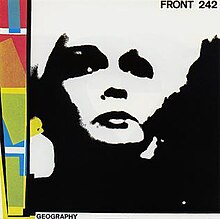
Hipparchus of Nicaea was a Greek astronomer, geographer, and mathematician. He is considered the founder of trigonometry but is most famous for his incidental discovery of precession of the equinoxes.

Claudius Ptolemy was a Greco-Roman mathematician, astronomer, geographer and astrologer. He lived in the city of Alexandria in the Roman province of Egypt, wrote in Koine Greek, and held Roman citizenship. The 14th-century astronomer Theodore Meliteniotes gave his birthplace as the prominent Greek city Ptolemais Hermiou in the Thebaid. This attestation is quite late, however, and, according to Gerald Toomer, the translator of his Almagest into English, there is no reason to suppose he ever lived anywhere other than Alexandria. He died there around AD 168.

Strabo was a Greek geographer, philosopher, and historian who lived in Asia Minor during the transitional period of the Roman Republic into the Roman Empire.

Ptolemy Neos Dionysos Theos Philopator Theos Philadelphos was a pharaoh of the Ptolemaic dynasty of Ancient Egypt. He was commonly known as Auletes, referring to the king's love of playing the flute in Dionysian festivals.
Berenice IV Epiphaneia was a Greek Princess and Queen of the Ptolemaic dynasty.

The history of geography includes many histories of geography which have differed over time and between different cultural and political groups. In more recent developments, geography has become a distinct academic discipline. 'Geography' derives from the Greek γεωγραφία – geographia, a literal translation of which would be "to describe or write about the Earth". The first person to use the word "geography" was Eratosthenes. However, there is evidence for recognizable practices of geography, such as cartography prior to the use of the term geography.

Coele-Syria, Coele Syria, Coelesyria, also rendered as Coelosyria and Celesyria, otherwise Hollow Syria, was a region of Syria in classical antiquity. It probably derived from the Aramaic for all of the region of Syria but more often was applied to the Beqaa Valley between the Lebanon and Anti-Lebanon mountain ranges. The area now forms part of the modern nations of Lebanon and Syria.

Cataonia was one of the divisions of ancient Cappadocia.

Cultural geography is a subfield within human geography. Though the first traces of the study of different nations and cultures on Earth can be dated back to ancient geographers such as Ptolemy or Strabo, cultural geography as academic study firstly emerged as an alternative to the environmental determinist theories of the early Twentieth century, which had believed that people and societies are controlled by the environment in which they develop. Rather than studying pre-determined regions based upon environmental classifications, cultural geography became interested in cultural landscapes. This was led by Carl O. Sauer, at the University of California, Berkeley. As a result, cultural geography was long dominated by American writers.

The Geography, also known by its Latin names as the Geographia and the Cosmographia, is a gazetteer, an atlas, and a treatise on cartography, compiling the geographical knowledge of the 2nd-century Roman Empire. Originally written by Claudius Ptolemy in Greek at Alexandria around AD 150, the work was a revision of a now-lost atlas by Marinus of Tyre using additional Roman and Persian gazetteers and new principles. Its translation into Arabic in the 9th century and Latin in 1406 was highly influential on the geographical knowledge and cartographic traditions of the medieval Caliphate and Renaissance Europe.
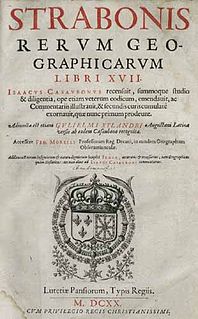
The Geographica, or Geography, is an encyclopedia of geographical knowledge, consisting of 17 'books', written in Greek by Strabo, an educated citizen of the Roman Empire of Greek descent. Work can have begun on it no earlier than 20 BC. A first edition was published in 7 BC followed by a gap, resumption of work and a final edition no later than 23 AD in the last year of Strabo's life. Strabo probably worked on his Geography and now missing History concurrently, as the Geography contains a considerable amount of historical data. Except for parts of Book 7, the complete work is known.
Arsinoe was an ancient city in northwestern Cyprus built on top of the older city, Marion ; some ancient writers conflate the two cities.
The Aspurgiani were an ancient people, a tribe of the Maeotae dwelling along east side of the Strait of Kerch along the Palus Maeotis in antiquity. They seem to be identical with the "Asturicani" of Ptolemy.
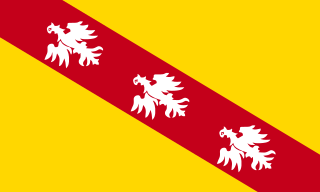
The Mediomatrici were an ancient Celtic people of Gaul, who belong to the division of Belgae. Julius Caesar shows their position in a general way when he says that the Rhine flows along the territories of the Sequani, Mediomatrici, Triboci or Tribocci, and Treviri. Ptolemy places the Mediomatrici south of the Treviri.
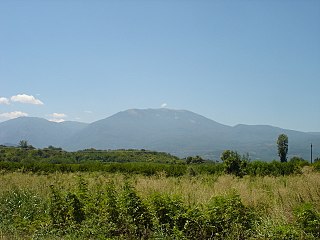
The Vermio Mountains, the ancient Bermion, is a mountain range in northern Greece. It lies between the Imathia Regional Unit of the Central Macedonia Region and the Kozani Regional Unit of the Western Macedonia Region. The range is west of the plain of Kambania. The town of Veria, which is the capital of Imathia, is built οn the foot of these mountains. The highest point in the range is the peak Chamiti, 2,065 metres (6,775 ft) elevation, west of Naousa.
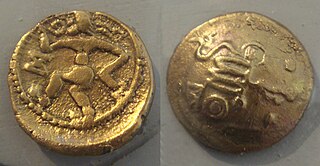
The Namnetes were a tribe of ancient Gaul, living in the area of the modern city of Nantes near the river Liger.
According to Strabo, the Artabri were an ancient Gallaecian Celtic tribe, living in the extreme north-west of modern Galicia, about Cape Nerium, outskirts of the city and port of Ferrol, where in Roman times, in the 1st century BC, a fishing port existed which also trade in metals as well as wild horsesin the bay of Ferrol most likely administered from nearby Nerium in an area dominated by the Artabri ) giving name to the Portus Magnus Artabrorum. Strabo reports several seaports among the Artabri. Ptolemy places them among Galaeci Lucenses and gives their capital town as Lucus Augusti.

El Mandara is a neighborhood in Alexandria, Egypt.

Lapathus, also recorded as Lapethus, Lepethis, and Lapithus, was an ancient Cypriot town near present-day Lampousa and Karavas.
Cape Sideros or Cape Sidero is a cape at the eastern end of the island of Crete, Greece. Anciently it was known as Samonium or Samonion, Sammonium or Sammonion, Salmonium or Salmonion (Σαλμώνιον) and Salmone (Σαλμώνη). It was here that the seamen of the Alexandrian vessel which conveyed Paul the Apostle to Rome, thinking they could pursue their voyage under the lee of the island, ran down. The cape is noted by many ancient secular writers including Strabo, Ptolemy, Pomponius Mela, and Pliny the Elder, and in the anonymous Stadiasmus Maris Magni.
